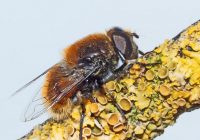Dr Phil Smith’s Wildlife Notes
March 2025
In my February notes I wondered whether the usual spring drought had started. I was right! The Met. Office tells us that March was extremely dry in the UK, many areas reporting less than 10 mm of rain. It was also the sunniest March in England since records began in 1910. Rachael Park’s Formby data showed we had 21.5 mm of rain, which is less than a third of the normal amount for March. The sand-dune water-table fell by 12 cm at the Devil’s Hole, despite that fact that March invariably sees an increase to the annual maximum. Such dry conditions bring the risk of large-scale wildfires, Pete Kinsella reporting several fires on the Crosby dunes during the month.
In a typical March, I enjoy searching the sand-dunes for winter-annuals, tiny flowers that open and shed their seed in the early spring, while the soil is still moist. This time, it was hardly worth the effort. Sea and Little Mouse-ears together with brilliant Early Forget-me-not were still there but the drought meant far fewer and even smaller plants than usual. The spring bulbs did much better, though almost all are non-native garden escapes, including the wealth of daffodil cultivars that brighten the dunescape. There are said to be over 13,000 varieties, one of my favourites being ‘Ice Follies’. As mentioned in previous notes, there is a small colony of genuine Wild Daffodils near the entrance to Ainsdale Sand Dunes National Nature Reserve. They appear towards the end of March, a little later than the cultivars but, this time, I found only about 20 flowers, though there were over 100 non-flowering plants. One of the earliest flowers is the Colt’s-foot, a bit like a succulent dandelion, whose blooms famously appear before the leaves. My first this year was at Crossens on 5th. One of the earliest willows to flower is Purple Willow, the glorious male catkins of which I was delighted to find at Larkhill on 8th.
Robert Freeth came over from Wirral on 26th for one of his regular botanical visits. He invariably sees something new. This time it was abundant Mossy Stonecrop, found by Steve Cross last year on the Lifeboat Road overflow carpark. This small, fleshy plant, bright red when mature, is intolerant of competition, being typical of sandy soils where the ground is kept open by disturbance. It is mainly found in north-east Scotland, East Anglia and southern England but has undergone a dramatic increase in its range over recent years, perhaps due to milder winters and accidental transport of seeds by vehicles. Nearby, I showed Robert the distinctive male catkins of the intensely rare Don’s Willow, while a diversion to Larkhill Heath was rewarded with the first catkins of Eared Willow on the only bush of this mostly upland species known for the Sefton Coast. It was another new tick for Robert. A small undeveloped site off Kirklake Bank, Formby, provided a good display of the strange-looking Moschatel or Townhall Clock,usually found in shady places on humus-rich soils.
March sees our Common Frogs and Common Toads assembling to breed. I counted about 50 spawn batches of Common Frog at the Devil’s Hole on 15th. A few days earlier, about 25 adults of both species were spawning at Wicks Lake. I stopped to listen to them for a few minutes. The male frogs were making a deep purring call, described as a “low-pitched guttural rasping roar … not very loud” in one of the field guides. This contrasted with the higher-pitched squeak of the Common Toads, the males jostling for mating rights with the females.
March birds were represented by winter visitors hanging on, together with early spring migrants. My first singing Chiffchaff was at Sands Lake on 19th, though others reported them much earlier. Two days later, Marshside/Crossens produced two Sand Martins, a White Wagtail, 100 Avocets and the amazing sight of four Spoonbills flying just over my head!
The dry conditions meant insects were slow to get going but, on 8th, I was amazed to see a male Brimstone butterfly motoring at high speed along Wicks Path. Two visits to Alexandra Park, Crosby, provided opportunities to see several Hairy-footed Flower Bees, while a barking dog alerted me to a less welcome Grey Squirrel.Hoverflies were represented especially by Common and Tapered Drone Flies, Hairy-eyed Flower Fliesand Spotted Thintails,all common species, while, towards the end of the month, they were joined by the less frequent Furry Drone Fly and Broad-banded Aphideater. As usual, the spectacular bumblebee mimic, Large Bumblefly was elusive, mainly flying around the tops of cherry and willow trees. However, I did eventually find one in Ainsdale NNR, basking briefly on a Sycamore trunk. On 31st, there was a big emergence of a smaller version of the familiar St Mark’s Fly. This was probably the Lesser Variable Bibio; mostly black, except for orange legs. It is said to be widespread and locally common in spring but I could find only two previous records for Sefton, perhaps because there aren’t many fly specialists about.






